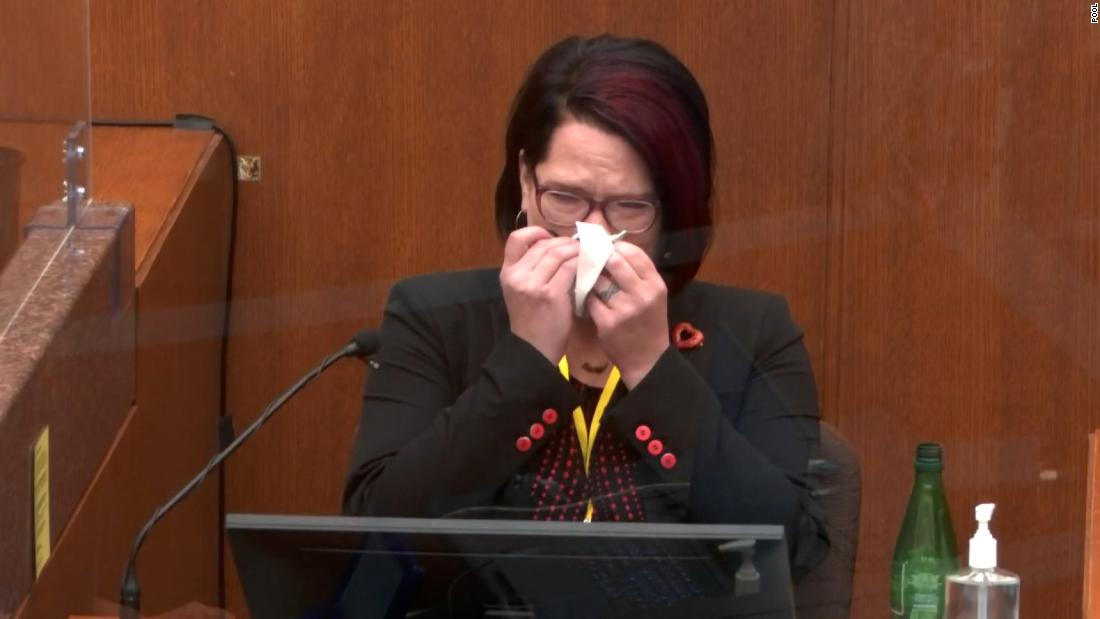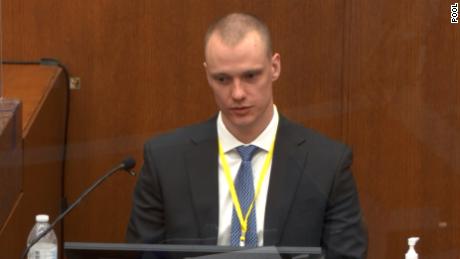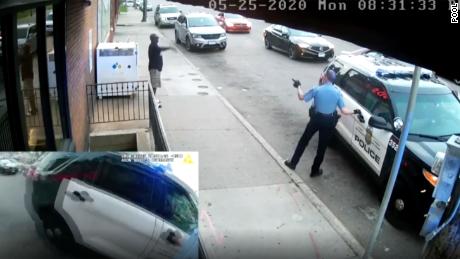George Floyd’s girlfriend says in Derek Chauvin trial they struggled with opioid addiction
Courteney Ross, 45, said she met Floyd in August 2017 when he worked as a security guard at the Salvation Army. In emotional testimony, she said they liked exploring the local sculpture garden and eating out on their dates together.
In March 2020, she found Floyd doubled over in pain and took him to the emergency room, she testified. He was in the hospital for several days due to an overdose, she said. She said she believed he had started using again in May 2020.
Chauvin, 45, has pleaded not guilty to charges of second-degree murder, third-degree murder and second-degree manslaughter.
In opening statements, prosecutors acknowledged Floyd’s history of opioid addiction but said it was irrelevant to why he died last May. However, defense attorney Eric Nelson has argued that Floyd’s true cause of death was drug use and several preexisting health issues.
“It’s because as the prosecutor, you want to present and address and resolve these bad facts. You don’t want to have the defense be able to say, ‘Hey, jury, why didn’t they tell you about this? Here are the things they don’t want you to know,'” Coates said.
Paramedic says Floyd flatlined in ambulance
Hennepin County paramedics Seth Bravinder and Derek Smith testified Thursday about treating an unresponsive, handcuffed Floyd on May 25, 2020.
They were first called to the scene with a non-emergency Code 2 for a mouth injury, but about a minute and half later, the call was upgraded to a Code 3 — meaning the ambulance uses lights and sirens.
When they arrived to the scene, Floyd did not appear to be breathing or moving, they testified. Smith checked Floyd’s pulse and pupils — with Chauvin still kneeling on him — and believed his heart had stopped.
“In layman terms, I thought he was dead,” Smith said.
They then moved to get him onto a stretcher, and Bravinder bent down and motioned for Chauvin to lift his knee off Floyd.
They decided to put Floyd into the ambulance so they could treat him in a controlled environment. The equipment for treating patients with a stopped heart is located in the ambulance, and Bravinder said they were concerned about the crowd of bystanders.
One officer, Thomas Lane, also got into the ambulance with them and helped with chest compressions. With Floyd inside, Bravinder drove the ambulance several blocks and then stopped to treat him further, he testified. Smith removed Floyd’s handcuffs with a set of handcuff keys, he testified.
Floyd was “asystole,” meaning he had flatlined and his heart showed no activity. They attempted to restart his heart with chest compressions and establishing an airway, but he did not recover. They ultimately dropped him off at the hospital with no change in his status.
“I showed up, he was deceased, and I dropped him off at the hospital, and he was still in cardiac arrest,” Smith said.
Chauvin defended kneeling on Floyd
One clip from Chauvin’s own body camera showed him defending his actions to a critical bystander just moments after Floyd’s limp body left the scene in an ambulance.
“That’s one person’s opinion,” Chauvin responded as he got into his squad car. “We had to control this guy because he’s a sizable guy. It looks like he’s probably on something.”
That comment was the first time jurors or the public have heard from Chauvin — and it may be the last. His attorney has not indicated whether he will testify in his own defense.
“I feel helpless,” he said through tears. “I don’t have a mama either. I understand him.”
Floyd’s friend to invoke Fifth Amendment
A man who was sitting in a car with Floyd when police approached and removed them from the vehicle says he will not testify in the trial.
Morries Hall will invoke the Fifth Amendment and not testify if he is called to the stand, according to a filing submitted by his public defender, Adrienne Cousins. Hall is listed on the prosecutors’ prospective witness list and is now asking the court to reject his subpoena since he will not testify.
On Wednesday, jurors watched video of Floyd, Hall and another passenger being removed by police from the Mercedes SUV they were sitting in across the street from Cup Foods.
A witness who worked at Cup Foods described Floyd and Hall each trying to use a $20 bill he identified as fake.
Hall fled Minnesota shortly after Floyd died, according to his August 2020 statement to investigators cited in court documents. He was eventually arrested in Texas on outstanding felony warrants issued by Minnesota prior to Floyd’s death, including one for being a felon in possession of a firearm.
Hall is also accused of trying to get rid of evidence the day Floyd died.
“Surveillance video from the nearby Dragon Wok restaurant shows that Mr. Hall appeared to use Mr. Floyd’s resistance as a distraction to destroy evidence,” a court document filed by the defense says.
“The video demonstrates that Mr. Hall watched through the windows of Mr. Floyd’s vehicle to ensure that he was not being observed by police, then … Mr. Hall furtively dropped something into the sewer drain on the street.”
Judge Peter Cahill has not yet ruled on Hall’s request to be released as a witness.
His public defender did not immediately return a call from CNN.
![]()










